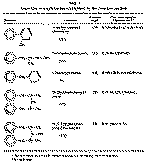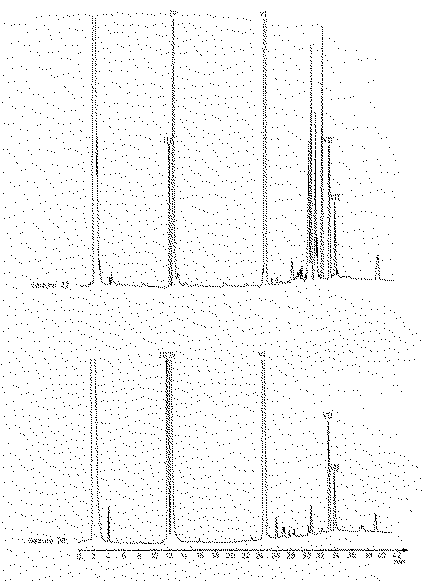|
|
|
|
Leuckart-specific impurities in amphetamine and methamphetamine seized in NorwaySectionsABSTRACT DetailsAuthor: M. LAMBRECHTS,, K. E. RASMUSSEN Leuckart-specific impurities in amphetamine and methamphetamine seized in NorwayM. LAMBRECHTS,K. E. RASMUSSEN Department of Pharmaceutical Chemistry, Institue of Pharmacy, University of Oslo, Oslo, Norway ABSTRACTSamples of 28 amphetamine and 7 methamphetamine seizures, taken in Norway from 1975 to 1982, were examined. The amphetamine and methamphetamine contents varied from 9 to 99 per cent and from 9 to 72 per cent respectively. Impurities originating from the synthesis of the illicit samples were identified by gas chromatography combined with mass spectrometry. Special attention was paid to "Leuckart-specific" impurities, which could indicate that the Leuckart method of amphetamine and methamphetamine synthesis had been used. N-formyl-methamphetamine, a Leuckart-specific compound, was identified in all the investigated samples of methamphetamine seized in Norway. The Leuckart-specific impurities, 4-methyl-5-phenyl-pyrimidine and N-formyl-amphetamine, were identified in 79 per cent of the amphetamine samples. IntroductionThe popularity of amphetamine and methamphetamine on the illicit drug market in Norway has increased in recent years. An amount of 755 g of central-nervous-system stimulants, mainly amphetamines, was seized in 1980 and 5,175 g in 1982 [l]. These drugs were most probably illegally imported into the country ; only one clandestine laboratory has been discovered in Norway. The seized material contained N-formylmethamphetamine, an intermediate in the Leuckart synthesis of methamphetamine. Amphetamine and methamphetamine can be synthesized by a variety of methods [2] , [3] . As incomplete reactions and Side-reactions easily occur in the manufacturing process, the unrefined products usually contain a number of impurities. Detection and identification of these by-products may, therefore, provide information about the method of synthesis. In this way, analysis of impurities in illicit amphetamine and methamphetamine can supply law enforcement officials with information concerning clandestine production. With knowledge of the methods and materials used for the synthesis, law enforcement officials can monitor the sale of available precursors which might lead to the detection of clandestine laboratories. The impurities found in illicit amphetamine and methamphetamine produced by different methods have been described by other authors [3] , [4] , [5] . In this report, attention is focused on the Leuckart method and the specific impurities found in amphetamine and methamphetamine synthesized by this method. Names, structures, molecular weights and mass spectrometry data of the impurities found by the authors in amphetamine and methamphetamine synthesized by the Leuckart method are summarized in tables l and 2. Compound l (table l) can be associated Specifically with the Leuckart synthesis of methamphetamine [5] and compounds III, IV and V (table 2) are regarded as Leuckart-specific impurities in amphetamine [3] . The presence of these compounds in illicit seizures indicates that the Leuckart synthesis has been used.  aThe m/e values of the most intense fragments in decreasing order of intensity. bB = base peak. An investigation of these impurities in amphetamine and methamphetamine produced by different experimental conditions of the Leuckart method has recently been carried out [6] . Gas chromatography combined with mass spectrometry was the method of choice for the identification of these impurities and this method has also been used in this study.  aThe m/e values of the most intense fragments in decreasing order of intensity. bB = base peak. Experimental conditionsChemicalsChemicals used were of analytical grade. Samples of amphetamine and methamphetamine seized in Norway from 1975 to 1982 were obtained from the Forensic Laboratory Department, National Bureau of Crime Investigation, Oslo, Norway and randomly selected for analysis. Quantitative determination of amphetamine and methamphetamineThe amphetamine and methamphetamine contents were determined by high-pressure liquid Chromatography (HPLC) [7] . The column was a 25 cm x 4.6 mm ID stainless-steel tube, slurry-packed with small-particle silica (6 µm Partisil-5). The solvent systems were methanol/2 N ammonia/1 N ammonium nitrate/water (270/10/5/15), pH 10? for the amphetamine determination and methanol/2 N ammonia/l N ammonium nitrate (270/20/10), pH 10, for the methamphetamine determination. A Glenco NSI 33 R-pump was used to deliver solvent at a flow rate of l ml/min and a Spectra Physics UV-detector (Model SP 8200) was used to monitor the eluent at 254 nm. Samples were introduced through a Rheodyne (Model 7120) injector equipped with an external 10 µl sample loop. Sample solutions were prepared at a concentration of 1 mg/ml in methanol/water solution (270/30). Peak height measurements were used to quantify the components. Detection and identification of Leuckart-specific impuritiesSample preparationAn amount of 300 - 500 mg amphetamine or methamphetamine was dissolved in 5 ml of distilled water, and 2 ml redistilled benzene was added. The pH of the aqueous phase was checked and made weakly acidic with 0. l M hydrochloric acid. Trace components were extracted into the benzene solvent by vigorous shaking for 4 min. After separation, most of the benzene layer was transferred into a glass tube and reduced in volume to 5 - 50 µl, depending on the purity of the sample [6] . Gas liquid chromatography (GLC)A Carlo Erba (Model 2101) gas chromatograph equipped with a flame ionization detector was used. A glass column (1 .8 m x 1 .2 mm ID) packed with 3 per cent SE-30 on Supelcoport 80 - 100 mesh was used. The nitrogen flow rate was 30 ml/min. The injector and detector temperatures were 280oC and 310oC respectively. Oven temperature was programmed from 1 30o to 280oC at 10oC/min. A Sample of volume l - 2 µl was injected into the chromatograph. Capillary gas chromatography (CGC)A Carlo Erba (Model 2900) gas chromatograph equipped with a flame ionization detector and a fused-silica capillary column (25 m x 0.33 mm ID), wall-coated with SE-30, was used. The injector and detector temperatures were both 275°C. The oven temperature was programmed from l30° to 145°C at 4°C/min, then isothermal 145°C for five minutes and from 145°C to 250°C at 4°C/min. Helium was used as a carrier gas and the flow rate was adjusted to 3.0 ml/min through the capillary column, 20 ml/min at the outlet of the splitter and 5 ml/min as septum flush. Samples of volume 2 µl were injected into the gas chromatograph. Gas chromatography/mass spectrometry (GC/MS)GC/MS was carried out using a VG Micromass MM 7070F. The electron energy was 70 eV. The mass spectrometer was connected to a Carlo Erba (Model 4200) gas chromatograph. SynthesisN-formylamphetamine and N-formylmethamphetamine were prepared for comparative purposes by formylation of amphetamine and methamphetamine [8] . The identity of the products was checked by mass spectrometry and infrared Spectrometry (Beckman Acculab 2 Spectrometer). Results and discussionSamples of 7 methamphetamine and 28 amphetamine seizures were investigated. The characteristics of the methamphetamine seizures are summarized in table 3. The methamphetamine content varied considerably - from 9 per cent to 72 per cent. The kind of diluents also varied greatly. Table 3Characteristics of methamphetamines seized in Norway, 1977-1979
The characteristics of the amphetamine seizures are summarized in table 4. Of the total of 28 seizures, 17 contained 20 to 70 per cent amphetamine, 9 more than 70 per cent, and 2 less than 20 per cent amphetamine. Sugar and glucose were often used as diluents. Table 4Characteristics of amphetamines seized in Norway, 1975-1982
Detection and identification of Leuckart-specific impuritiesMethamphetamineDetection and identification was by GC/MS. The results of the impurity investigation of methamphetamine seizures are recorded in table 5 table 5. Table 5Impurities in seven methamphetamine samples
Compound I? which is a Leuckart specific impurity, was found in all of the seizures, direct evidence that the products were synthesized by the Leuckart method. Compound II? which can also be obtained as a by-product in the Leuckart synthesis of methamphetamine [4] , was present in four samples. A reactant in the Leuckart synthesis, benzyl methyl ketone, appeared in four seizures. The samples contained few impurities that proceeded from the synthesis and their concentrations were low. For this reason, the benzene extract had to be concentrated to about 5 µl. This observation suggests that the producers had used great skill in purifying the products. A quantitative estimate based on four samples indicated that the amount of impurity I was lower than 0.02 per cent. AmphetamineSamples 1 to 18 were examined for compounds III and IV, which are the Leuckart-specific impurities [9] . Samples 19 to 28 were studied in more detail to get information about the main impurities present. The results are recorded in table 6. Table 6 shows that compound III was detected by GC/MS in 22 samples and compound IV in 17 of the same samples. These results confirmed that at least 22 seizures were synthesized by the Leuckart method. Samples 10, 11, 12, 13 and 15 contained small amounts of impurities. Compounds III and IV were not detected in these samples. Investigation of samples 19 to 28 showed that compound VII, the presence of which also provides strong evidence of the use of the Leuckart synthesis [10] , was present in high quantities in 8 of the 10 samples. Compound V was not detected in samples 19 to 28, while compound VI? which is not regarded as a Leuckart specific impurity, was found in nine seizures. Table 6Impurities in 28 ampbetamine samples
Compound II? usually found in Leuckart-synthesized methamphetamine, was identified in four samples. The high boiling pyridines 1(according to van der Ark and others [11] ) were found in six samples. However, low concentrations, incomplete separation and rather similar mass spectra made it difficult to obtain exact data for these compounds and they were therefore excluded from table 6. With the exception of sample 20, the Leuckart synthesized Samples showed similar chemical signatures (impurity chromatograms) [12] . Gas chromatographic runs of samples 22 and 28 are given in the figure. 14-methyl-5-phenyl-2-benzylpyridine:2,4-dimethyl-3,5-diphenylpyridine:2,4-dimethyl-3-phenyl-6-benzylpyridine; 2-methyl-3-phenyl-6-benzylpyridine: 2,6-dimethyl-3,5-diphenylpyridine. Figure Capillary gas chromatograms of two amphetamine seizures Typical Leuckart signatures were encountered in both samples. The GLC doublet of compound VII is probably caused by steroisomerism [10] . Compound IV was present in concentrations lower than l per cent in samples l to 19. ConclusionBy analyzing for Leuckart-specific impurities, it is possible to determine whether illict amphetamine and methamphetamine have been synthesized by the Leuckart method. Such an investigation by GC/MS showed that the amphetamine and methamphetamine seized in Norway from 1975 to 1982 were most frequently synthesized by this method. AcknowledgmentThe samples of amphetamine and methamphetamine were provided by the Forensic Laboratory Department, National Bureau of Crime Investigation, Oslo, Norway. References01T. Kjeldsen, National Bureau of Crime Investigation, Oslo, Norway. Personal communication, 1983. 02R. S. Frank, "The clandestine drug laboratory situation in the United States", Journal of Forensic Sciences, vol. 28, No. l, 1983, p. 18. 03A. Sinnema and A. M. A. Verweij, "Impurities in illicit amphetamine: a review", Bulletin on Narcotics (United Nations publication), vol. 33, No. 3, 1981, pp. 37 - 54. 04R. P. Barron and others, "Identification of impurities in illicit methamphetamine samples", Journal of the Association of Official Analytical Chemists, vol. 57, No. 5, 1974, p. l 147. 05T. C. Kram and A. V. Kreugel, "The identification of impurities in illicit methamphetamine exhibits by gas chromatography/mass spectrometry and nuclear magnetic resonance spectroscopy", Journal of Forensic Sciences, vol. 22, No. l, 1977, p. 40. 06M. Lambrechts and others, "Analysis of Leuckart-specific impurities in amphetamine and methamphetamine", Journal of Chromatography, vol. 284, 1984, p. 499. 07I. Jane, "The separation of a wide range of drugs of abuse by high pressure liquid chromatography", Journal of Chromatography, vol. lll, 1975, p. 227. 08M. LeBelle and others, "Identification of a major impurity in methamphetamine", Journal of Pharmaceutical Sciences, vol. 62, 1973, p. 862. 09T. Klemetsrud, M. Sc. Thesis, Oslo, Norway, 1981. 10T. C. Kram, "Re-identification of a major impurity in illicit amphetamine", Journal of Forensic Sciences, vol.24, No.3, 1979, p.596. 11A. M. van der Ark, A. M. A. Verveij and A. Sinnema, "Weakly basic impurities in illicit amphetamine", Journal of Forensic Sciences, vol.23, No.4, 1978, p.693. 12L. Stromberg, "Comparative gas chromatographic analysis of narcotics. II Amphetamine sulphate", Journal of Chromatography, vol.106,1975, p.335.
|
|||||||||||||||||||||||||||||||||||||||||||||||||||||||||||||||||||||||||||||||||||||||||||||||||||||||||||||||||||||||||||||||||||||||||||||||||||||||||||||||||||||||||||||||||||||||||||||||||||||||||||||||||||||||||||||||||||||||||||||||||||||||||||||||||||||||||||||||||||||||||||||||||||||||||||||||||||||||||||||||||||||||||||||||||||||||||||||||||||||||||||||||||||||||||||||||||||||||||||||||||||||||||||||||||||||||||||||||||||||||||||||||||||||||||||||||||||||||||||||||||||
|